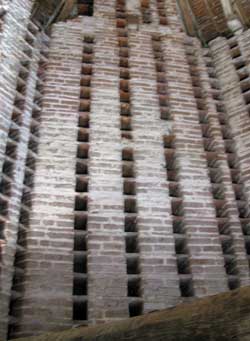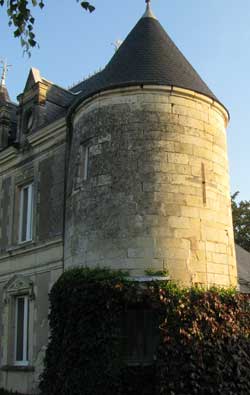
 |
 |
Amboise Dovecote |
|
On our way back to Paris and the airport, we visited the chateau where Leonardo da Vinci spent his last years, in Amboise, and to our delight, on the grounds, found one of the most unusual dovecotes we have ever found. What would one expect of a da Vinci design?
The dovecote consists of a square exterior and octagonal interior, and is built of brick, tufa limestone and mortar. The structure is 24 feet square on the outside, 22 feet across on the inside, with the nestholes raised up off the floor but reaching up into the eaves, as can be seen in the photographs. In all, the dovecote contains 1,000 “boulines” (nest boxes). This unique octagon interior design allowed for the use of a potence to assist in harvesting the squabs. The square exterior left extra depth for the nest boxes at the corners,and this space was not wasted, but rather used to provide an extra "bedroom" for these corner nest holes, providing the lucky pairs with extra space to boost productivity as pigeons are apt to do. The close up illustrates this construction of brick and tile. The nest hole entry opens to a nest hole of about 12 inches square, with all nestholes curving to the left from the opening rather than alternating left and right by row, which is the much more common practice.
The angles between the outer and inner walls also provided a constant circulation of air deemed essential for the successful hatching and rearing of young birds. Two thirds of the way up the outside wall is the “larmier”, (rat course) a flat outcrop of projecting stones, convex on its lower side, to which slates were nailed to prevent predators--rats, ferrets, weasels--from climbing into the dovecote to steal eggs, drink the blood of young pigeons, and drive away the parent birds. A gap at the base of the roof timbers provided entry and exit from the dovecote for the birds. This method of entry increased the need for a rat course, since the roof overhang would not have inhibited entry of climbing predators. The roof is covered in flat tiles and topped by a finial in the form of a phallus, symbolizing fertility.
The ground floor of the dovecote was given over to poultry, which were fed, but the upper reaches were reserved for the pigeons that would fly out every day to forage in the surrounding fields.
From information posted on the site, we again learned that "the dovecote was a sign of power and wealth, and played an important economic and social role in the Middle Ages. At a time when meat was in short supply and was preserved by salting, fresh meat and eggs were a prized addiction to any table. Pigeon squabs were a welcome change from salt meat, and pigeon eggs were widely used by the chefs of the royal household whose task it was to feed the court on its travels, serving between 3,000 and 5,000 meals at every sitting. Young pigeons were also fed to the falcons used for hunting. Pigeons were a useful source of concentrated fertilizer, known as columbine, widely used to improve the soil of the vinery and a source of considerable revenue. Pairs of pigeons were also given as gifts by monasteries and nobles as a mark of consideration for the recipients. Pigeon feathers were used by cushion makers to make quilts and feather beds, and by the plumassiers to ornament costumes for the court entertainments devised by Leonardo da Vinci. The express messengers of their age, pigeons also carried messages, attached to their ringed legs, from chateau to chateau."
The dovecote or “fuye” of the Chateau du Clos Luce was built in 1480 by Etienne le Loup, who rose from the position of cook’s assistant to become Master of the Household and adviser to King Louis XI, and later forester of the forests of Amboise and Montrichard, bailiff of Amboise and owner of the estate.
 |
Saumur Dovecote |
We were out of Bretagne today, so our list of known dovecotes was at an end. But just by chance we stayed at Domain de Presley, our hotel in Saumur. This grand little hotel, that was formerly a very small chateau, did indeed have a converted dovecote built into the end of the building, and we were able to snap a picture of it. The owner acknowledged that it had been a dovecote indeed, although abandoned for that purpose, when they acquired it. Perhaps that is why the finial still sports a pigeon at the very top.
This ends our trip visiting the dovecotes of France. While there are many more dovecotes/Pigeonniers in France, we focused on the area of Brittany. We hope you enjoyed your visit. If you are a French reader and would care to translate these pages into French, we would be more than pleased to post them with our gratitude. It seems sad that web pages devoted to French pigeonniers are not published in French.
Your hosts, John Verburg & Helen Bresler
DAY |
||||||||||||||||||
| 00 | 01 | 02 | 03 | 04 | 05 | 06 | 07 | 08 | 09 | 10 | 11 | 12 | 13 | 14 | 15 | 16 | 17 | |